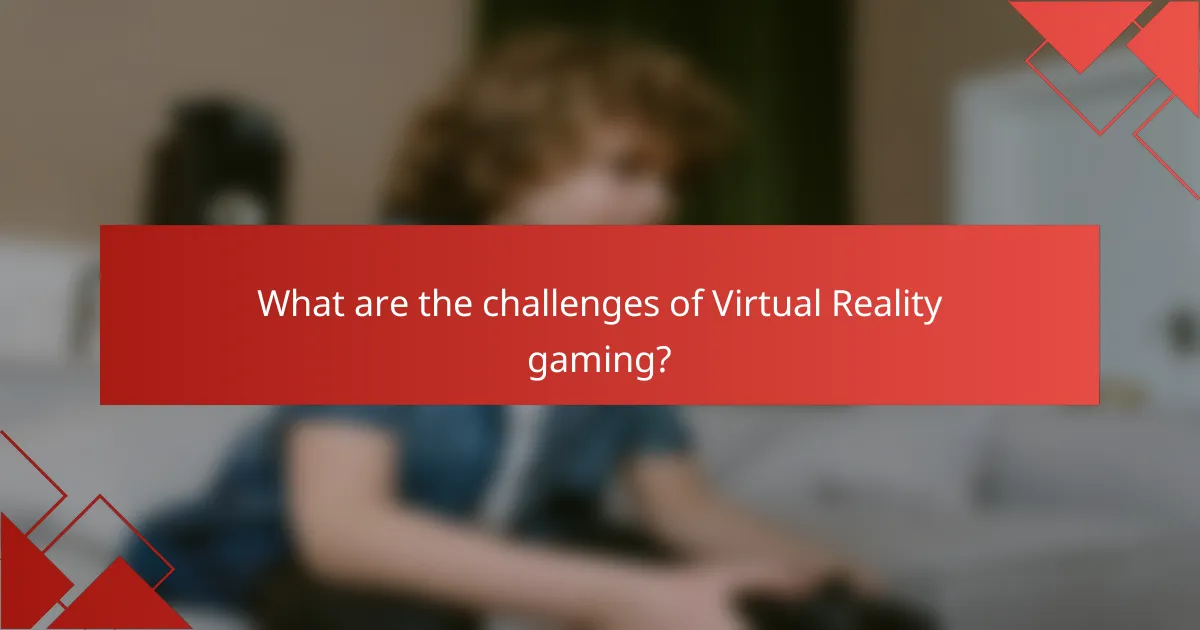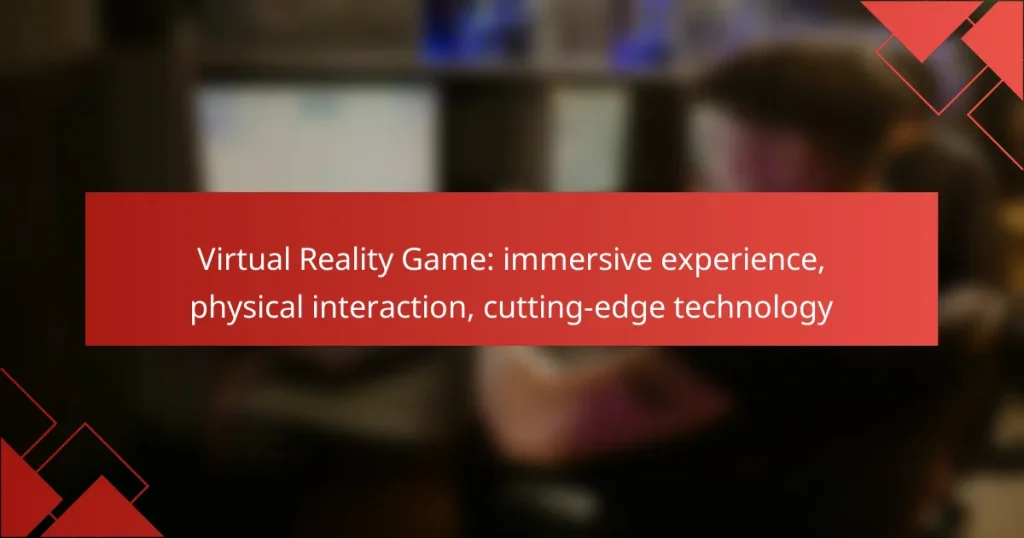Virtual Reality (VR) gaming revolutionizes the way players engage with games by offering immersive environments and physical interaction that traditional gaming cannot replicate. Utilizing cutting-edge technology, VR creates lifelike simulations that enhance gameplay, making titles like Half-Life: Alyx and Beat Saber standout experiences. With advanced components such as head-mounted displays and motion tracking systems, VR gaming delivers a unique and engaging adventure for players.

How does Virtual Reality enhance gaming experiences in the UK?
Virtual Reality (VR) significantly enhances gaming experiences in the UK by providing players with immersive environments, physical interaction, and realistic simulations. These elements combine to create a more engaging and lifelike gaming experience that traditional gaming cannot match.
Immersive environments
Immersive environments in VR games transport players to richly detailed worlds that feel real. By using advanced graphics and sound design, these environments draw players into the game, making them feel as though they are part of the action. For example, a VR game set in a fantasy realm allows players to explore vast landscapes, interact with characters, and experience dynamic weather systems.
These environments often utilize spatial audio and haptic feedback to enhance realism. Players can hear sounds coming from specific directions and feel vibrations that correspond to in-game events, further deepening their immersion.
Physical interaction
Physical interaction in VR games allows players to engage with the game world using their bodies. This can include actions like reaching out to grab objects, dodging attacks, or even performing complex movements. Such interactions create a sense of presence that is often missing in traditional gaming.
Many VR systems use motion controllers that track hand movements, enabling players to manipulate their surroundings intuitively. This level of engagement can lead to more satisfying gameplay experiences, as players feel more connected to their actions and outcomes.
Realistic simulations
Realistic simulations in VR games replicate real-world physics and scenarios, enhancing the overall gaming experience. For instance, racing games can simulate the feel of driving a car, while flight simulators can provide an authentic piloting experience. These simulations can be particularly appealing to players looking for a more authentic challenge.
Moreover, VR technology can be used for training purposes, such as in military or medical simulations, where realistic scenarios are crucial for skill development. This practical application of VR not only enhances gaming but also serves educational and professional purposes.

What are the best Virtual Reality games available in the UK?
The best Virtual Reality games in the UK offer immersive experiences that combine cutting-edge technology with physical interaction. Titles like Half-Life: Alyx, Beat Saber, and The Walking Dead: Saints & Sinners stand out for their engaging gameplay and innovative mechanics.
Half-Life: Alyx
Half-Life: Alyx is a groundbreaking VR title that immerses players in a richly detailed world filled with puzzles and combat. Set in the Half-Life universe, it leverages advanced physics and environmental interaction, allowing players to manipulate objects and engage in combat in a highly realistic manner.
Players should consider their VR setup, as the game requires a compatible headset and sufficient space for movement. The experience is enhanced by its storytelling and visual fidelity, making it a must-play for VR enthusiasts.
Beat Saber
Beat Saber is a rhythm-based game that combines music with physical activity, requiring players to slash through blocks in time with the beat. The game is accessible to all skill levels, making it a popular choice for both casual gamers and serious players looking for a workout.
When playing, ensure you have enough room to swing your controllers freely. The game features a variety of music genres and difficulty levels, allowing players to customize their experience. Regular updates add new songs, keeping the gameplay fresh and engaging.
The Walking Dead: Saints & Sinners
The Walking Dead: Saints & Sinners offers a survival horror experience where players navigate a post-apocalyptic world filled with zombies. The game emphasizes physical interaction, requiring players to scavenge for resources, craft items, and engage in combat using realistic mechanics.
Consider your approach to gameplay; you can choose to be stealthy or aggressive, which affects your survival chances. The game also features a compelling narrative and moral choices that impact the story, enhancing replayability and immersion.

Which technologies power Virtual Reality gaming?
Virtual Reality (VR) gaming relies on several advanced technologies that create immersive experiences and enable physical interaction. Key components include head-mounted displays, motion tracking systems, and haptic feedback devices, each contributing to the overall realism and engagement of the gaming experience.
Head-mounted displays
Head-mounted displays (HMDs) are essential for VR gaming, providing the visual interface that immerses players in virtual environments. These devices typically feature high-resolution screens and wide fields of view to enhance realism. Popular models include the Oculus Quest and HTC Vive, which offer varying levels of performance and comfort.
When selecting an HMD, consider factors such as resolution, refresh rate, and compatibility with your gaming system. A higher resolution and refresh rate can significantly improve visual clarity and reduce motion sickness, making for a more enjoyable experience.
Motion tracking systems
Motion tracking systems are crucial for translating physical movements into the virtual space, allowing players to interact naturally with their environment. These systems can use external sensors or built-in cameras to track head, hand, and body movements with high precision.
Common technologies include optical tracking, which uses cameras to detect markers, and inertial tracking, which relies on accelerometers and gyroscopes. When choosing a motion tracking system, ensure it offers low latency and high accuracy to maintain immersion and prevent disorientation during gameplay.
Haptic feedback devices
Haptic feedback devices enhance the VR experience by providing tactile sensations that correspond to in-game actions. These devices can range from simple controllers that vibrate to advanced suits that simulate touch and movement, adding another layer of realism to the gaming experience.
When considering haptic feedback options, look for devices that offer adjustable intensity and a variety of feedback types. This can help create a more engaging experience, as players can feel the impact of their actions, such as the recoil of a weapon or the sensation of walking on different surfaces.

What are the benefits of Virtual Reality in gaming?
Virtual Reality (VR) in gaming offers immersive experiences that enhance player engagement and interaction. By utilizing cutting-edge technology, VR creates a virtual environment where players can physically interact with the game world, leading to a more captivating and enjoyable experience.
Enhanced engagement
VR significantly boosts engagement by immersing players in a 360-degree environment that feels real. This heightened sense of presence allows players to explore and interact with the game world in ways that traditional gaming cannot match. For instance, players can look around, reach out, and manipulate objects, making gameplay more dynamic and exciting.
To maximize engagement, developers often incorporate sensory feedback, such as haptic feedback and spatial audio, which further deepens the immersive experience. Players are likely to spend longer periods in VR, as the compelling nature of the environment keeps them invested in the gameplay.
Improved social interaction
Virtual Reality enhances social interaction by allowing players to connect in shared virtual spaces, regardless of their physical location. Players can meet, communicate, and collaborate in real-time, creating a sense of community that is often missing in traditional gaming formats. This social aspect is particularly beneficial for multiplayer games where teamwork and communication are crucial.
Many VR platforms support voice chat and avatar customization, enabling players to express themselves and build relationships within the game. This can lead to lasting friendships and a more fulfilling gaming experience, as players engage with others who share their interests.
Increased accessibility
VR gaming has the potential to increase accessibility for players with disabilities. Adaptive controllers and customizable settings allow individuals with varying physical abilities to enjoy gaming in a way that suits their needs. For example, VR can offer alternative control schemes that accommodate different levels of mobility.
Moreover, VR can provide experiences that may not be possible in the real world, such as exploring distant locations or engaging in activities that might be physically challenging. This inclusivity helps broaden the gaming audience and ensures that more players can participate in the virtual gaming community.

What are the challenges of Virtual Reality gaming?
Virtual Reality (VR) gaming presents several challenges that can hinder the overall experience. Key issues include motion sickness, high hardware costs, and limited content variety, each affecting user enjoyment and accessibility.
Motion sickness
Motion sickness in VR occurs when there is a disconnect between visual input and physical sensations. This can lead to symptoms like dizziness, nausea, and discomfort, particularly during fast movements or when the virtual environment does not match the user’s physical movements.
To minimize motion sickness, developers often implement techniques such as reducing frame latency to low tens of milliseconds and providing options for users to adjust movement speed. Users can also take breaks and gradually acclimate to VR environments to help reduce symptoms.
High hardware costs
The cost of VR gaming can be a significant barrier for many potential users. High-quality VR headsets and compatible hardware, such as powerful gaming PCs or consoles, can range from several hundred to over a thousand dollars. This investment may not be feasible for everyone.
To mitigate costs, users can look for budget-friendly VR options or consider standalone headsets that do not require additional hardware. Additionally, some platforms offer subscription services that allow access to a library of games without the need for multiple purchases.
Limited content variety
While the VR gaming market is growing, the variety of available content remains limited compared to traditional gaming platforms. Many VR titles focus on specific genres, which can lead to repetitive experiences for users seeking diverse gameplay.
To enhance content variety, developers are increasingly experimenting with different genres and gameplay mechanics. Users can explore indie titles and emerging VR experiences to find unique offerings, while also keeping an eye on upcoming releases that may expand the gaming landscape.


